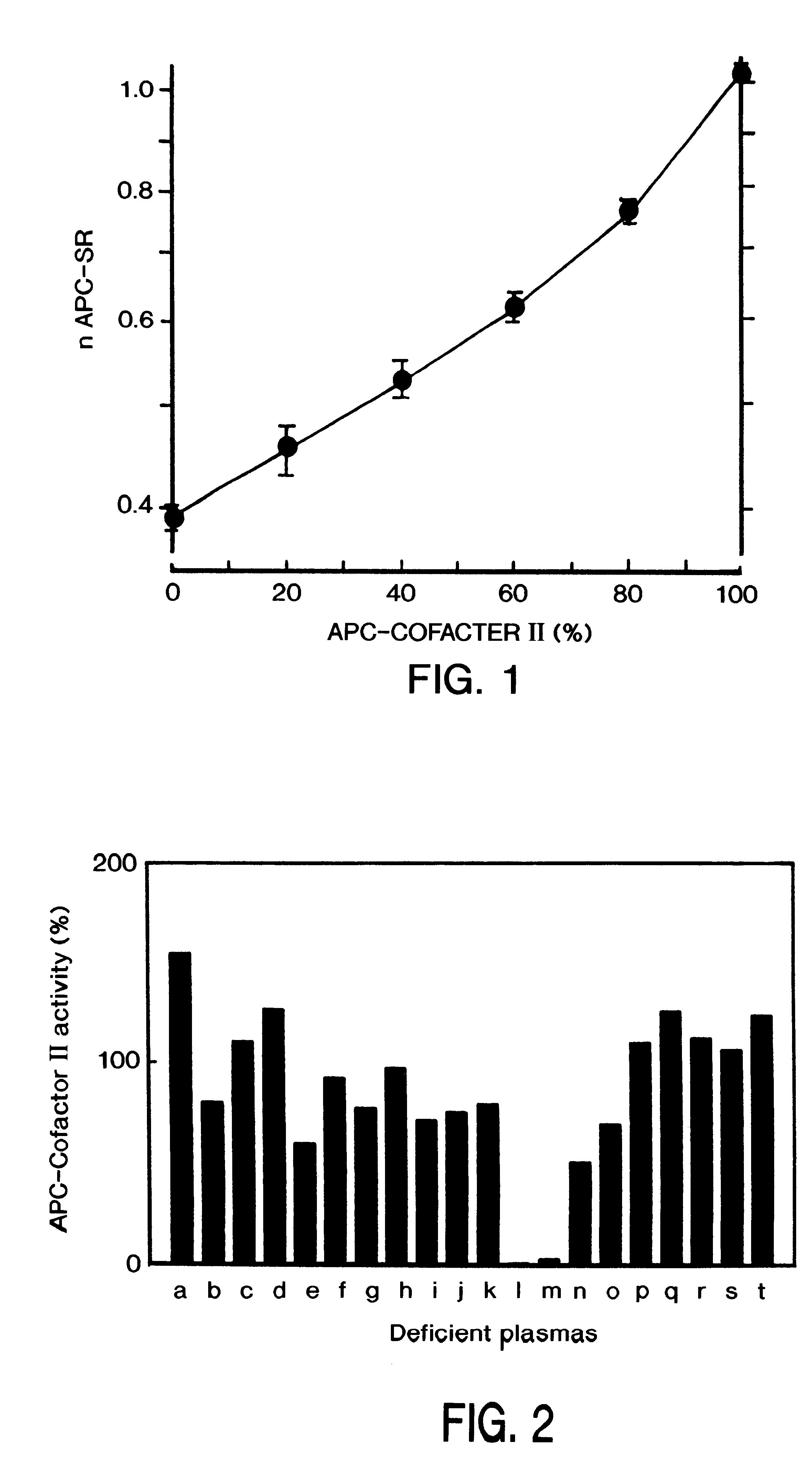Method for diagnosing an increased risk for thrombosis or a genetic defect causing thrombosis and kit for use with the same
a genetic defect and thrombosis technology, applied in the field of genetic defect causing thrombosis or increased risk for thrombosis and kit for use with the same, can solve the problems of increasing relative risk, no parameter seemed more useful for this purpose, and increasing the risk of apc respons
- Summary
- Abstract
- Description
- Claims
- Application Information
AI Technical Summary
Problems solved by technology
Method used
Image
Examples
example 1
Recently a poor anticoagulant response to APC ("APC-resistance" (Ref. 2)) was found in the plasma of 21% of unselected consecutive patients with thrombosis (Lancet, Dec. 18, 1993, Vol. 342, pp. 1503-1506, T. Koster et al) and about 50% of selected patients with a personal or family history of thrombosis (Ref. 8 and Blood, Vol. 82. No. 7 (October 1), 1993: pp. 1989-1993, J. H. Griffin et al). Here we demonstrate that the phenotype of APC-resistance is associated with heterozygosity or homozygosity for a single point mutation in the factor V gene (1691, G.fwdarw.A) which predicts the synthesis of a factor V molecule -FV (Q506) or FV Leiden-which is resistant to inactivation by APC. The allelic frequency of the mutation in the Dutch population is about 2% and is at least ten-fold higher than that of all known genetic risk factors for thrombosis (protein C-- (Ref. 17), protein S-- (Ref. 30), antithrombin III (Ref. 31) deficiency) together (Ref. 32).
Our previous finding that 5% of appare...
example 2
We investigated the risk of venous thrombosis in individuals heterozygous and homozygous for a mutation in coagulation factor V (factor V Leiden) abnormality. We determined the factor V Leiden genotype in 471 consecutive patients aged under 70 with a first objectively confirmed deep-vein thrombosis and in 474 healthy controls. We found 85 heterozygous and 7 homozygous individuals among the cases with thrombosis, and 14 heterozygous individuals among the control subjects.
Whereas the relative risk was increased seven-fold for heterozygous individuals, it was increased 80-fold for homozygous individuals. These experienced their thrombosis at a much younger age (32 versus 44 years). The homozygous individuals were predominantly women, with mostly blood group A.
Because of the increased risk of thrombosis with age, the absolute risk difference is most pronounced in older patients, both for heterozygous and homozygous individuals. For the homozygous individuals, the absolute risk becomes s...
example 3
Plasmids and in Vitro RNAs
RNA isolated from PBMCs of a healthy person (homozygous wild-type) and of two patients, ID90 and ID137 (homozygous mutant, both) was obtained from the Hemostatis and Thrombosis Research Centre, Leiden, the Netherlands. Fragments of 297 nt encompassing the mutation at position amino acid 506 were cloned in the vector pG30 using the restriction enzymes EcoRI and Csp451. The resulting plasmids were named pG30 / FVwt and pG30 / FVmut for wild-type and mutant clones respectively.
Cloning of the correct sequence was confirmed by sequence analysis and subsequently the plasmids were purified by CsCl gradient for in vitro RNA synthesis. Using plasmid pG30 / FVwt as a source a system control plasmid (pG30 / FV E2) was constructed by deletion of the probe sequence (21 nt) and insertion of the E2 sequence (144 nt). The 3 plasmids described above were used for in vitro RNA transcription using T7 RNA polymerase in the standard protocol. The plasmids were linearized with BamH1 whi...
PUM
| Property | Measurement | Unit |
|---|---|---|
| Fraction | aaaaa | aaaaa |
| Fraction | aaaaa | aaaaa |
| Fraction | aaaaa | aaaaa |
Abstract
Description
Claims
Application Information
 Login to View More
Login to View More - R&D
- Intellectual Property
- Life Sciences
- Materials
- Tech Scout
- Unparalleled Data Quality
- Higher Quality Content
- 60% Fewer Hallucinations
Browse by: Latest US Patents, China's latest patents, Technical Efficacy Thesaurus, Application Domain, Technology Topic, Popular Technical Reports.
© 2025 PatSnap. All rights reserved.Legal|Privacy policy|Modern Slavery Act Transparency Statement|Sitemap|About US| Contact US: help@patsnap.com



